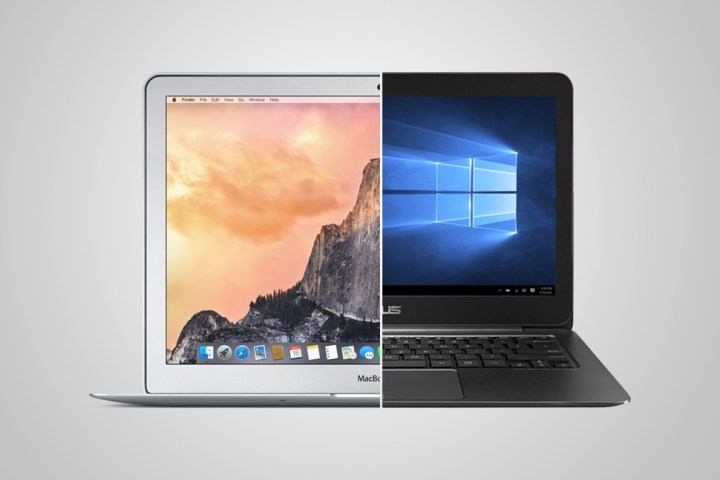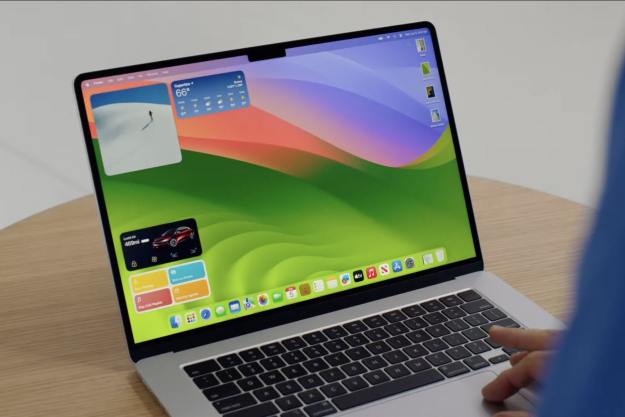
| Macbook Air 13-inch (2015)
|
Asus Zenbook UX305CA
|
|
| Dimensions | 12.8 x 8.94 x 0.11-0.68 (in) | 12.8 x 8.9 x 0.5 (in) |
| Weight | 2.96 pounds | 2.65 pounds |
| Keyboard | Full size, backlit keyboard | Full size, not backlit |
| Processor | Intel Core i5-5250U (3M Cache, up to 2.7 GHz) | Intel Core m3 6Y30 (4M Cache, up to 2.2 GHz) |
| RAM | 8GB of 1600MHz LPDDR3 | 8GB of 1866MHz DDR3L |
| Graphics | Intel HD Graphics 6000 | Intel HD Graphics 515 |
| Display | 13.3-inch LED-backlit with IPS technology | 13.3-inch Full HD LED-backlit with IPS technology |
| Resolution | 1,440 x 900 | 1,920 x 1,080 |
| Storage | 128GB PCIe-based onboard flash storage | 256GB SSD |
| Networking | 802.11ac, Bluetooth 4.0 | 802.11ac |
| Ports | USB 3.0, Thunderbolt 2, SDXC card reader, headset jack | USB 3.0, SDXC card reader, headset jack, micro HDMI |
| Webcam | 720p FaceTime camera | HD Camera |
| Operating System | Mac OS X El Capitan | Windows 10 |
| Battery | 54-watt-hour | 45-watt-hour |
| Price | $1,000+ | $700+ |
| Available from | Apple | Amazon |
| Review | 4 out of 5 | 4.5 out of 5 |
Specifications
The UX305CA has an Intel Core M processor, specifically the M3 6Y30. Core M processors are designed to be smaller and, in theory, much more energy efficient than typical laptop processors – but that comes at the cost of processing power. The Zenbook’s processor has a base clock speed of 900MHz, but can Turbo Boost up to 2.2GHz. Meanwhile the Macbook Air’s Intel Core i5 has a base speed of 1.6GHz with a 2.7GHz Turbo Boost.
The Air’s processor is thus a bit more powerful, however the m3 is not without advantages. The latter chip has a lower power draw and no fan, which makes for a lighter, quieter laptop. Moreover, it can run pretty much any application that a typical laptop user will ever need, so long as they don’t try to run too many at once.
One thing the Macbook Air is particularly notable for is its long battery life. When we tested the 2013 model using the Peacekeeper browser benchmark, the battery lasted six hours and 45 minutes. The Asus, meanwhile, only managed five hours and 25 minutes.

Both laptops have 8GB of RAM, although the Zenbook’s is faster, clocking in at 1,866MHz compared to the Air’s 1,600MHz. Neither computer is suited for tasks like high-end gaming, but for everyday applications and productivity, both are adequate.
The Air’s display only sports 1,440 x 900-pixel resolution, which already would put it at a disadvantage against similarly priced ultrabooks. The UX305CA touts 1,920 x 1,080-pixel resolution, a much better resolution that is far more common in today’s modern ultrabooks. The Air’s screen is glossy, while the Zenbook’s is matte, and whether you prefer one or the other is a tricky question. Glossy screens tend to have sharper colors and better contrast than matte screens, because matte screens have a polarizing layer that diffuses light. The upside is that matte screens reduce glare, whereas glossy screens are highly reflective. Glossy users will have to consider the lighting in environments they are working in. The UX305CA’s screen is also better than the average matte display, and provides solid image quality that is especially impressive given the Zenbook’s low price point.
The $700 UX305CA comes with 256GB of storage as the standard. In contrast the base model Air, at $1,000, comes with only 128GB of storage. To reach 256GB requires you to upgrade to the $1,200 model.
Winner: Asus
Design
Apple has not updated the design of the Air in years, and while some may say it’s better not to fix what isn’t broken, that mentality has given competitors a chance to catch up. With the UX305CA, Asus has managed to craft a sleek laptop to rival the Air. The two laptops have almost identical dimensions, though the Air does have its signature tapered edge. Weighing in at 2.96 pounds, the Air is a little heavier than the Zenbook (2.65 pounds), but it’s not a difference most people will probably notice.
Both laptops are built out of aluminum, with unibody designs that keep them thin and lightweight. The aesthetics are largely a matter of preference. The Macbook Air retains the classic Apple look, silver and svelte, but it’s a design that’s a bit tired at this point, especially given that newer Macbook’s have tweaked the formula a bit. Meanwhile, the Zenbook’s “obsidian” color, which seems to shift depending on the lighting, gives it a more dynamic look, as if it were actually carved from stone.
Both laptops have full, responsive keyboards. However, th eZenbook’s doesn’t have backlit keys, which may deter any night owls in need of a new machine. The Zenbook edges out the Air in terms of connectivity, though, with three USB 3.0 ports as opposed to two.
Winner: Tie
Price and availability
There’s no competition here. At $700, the UX305CA is not only $300 less than the 13-inch Macbook Air, but it’s one of the best ultrabooks at its price point, period. As previously mentioned, it comes with 256GB of storage, which is twice that of the base Macbook Air. Anyone who wants that same storage on the Macbook will have to pay $1,200, a hefty increase over the Zenbook.
Those who like the UX305CA but want a touchscreen can upgrade to a Quad-HD+ touchscreen — and 3,200 x 1,800-pixel resolution— for a total cost of $800, still a pittance relative to the Air. Macbook users can upgrade to a model with 512GB of storage for the total price of $1,500.
Winner: Asus
Conclusion
Like the pyramids, the Macbook Air is a beautiful relic; once a symbol of prestige, it is now a lower tier Apple product, shown up not only by newer Macbooks but by rival ultrabooks like the Asus Zenbook UX305.
While the Macbook Air does outperform the UX305 in some technical aspects (notably packing a faster processor), the difference is not so great as to justify the vast gulf in pricing. Both laptops fill the same niche, more or less, offering productivity in slender packages.
The Asus Zenbook UX305CA, however, offers a robust ultrabook for consumers on a budget. Users who are invested in the Apple ecosystem but don’t want to drop money on one of the company’s latest offerings will find the Air an adequate budget option, but everyone else should take a long look at the UX305. After all, despite making some sacrifices to cut down on size, it offers one of the best performance-to-cost values around.
Editors' Recommendations
- Best Apple deals: Save on AirPods, Apple Watch, iPad, MacBook
- This is one of my favorite Windows laptops. But can it beat the MacBook Air?
- Apple’s serious miscalculation with the 15-inch MacBook Air
- Intel chips held back the 15-inch MacBook Air, Apple says
- There’s great news if you want to buy Apple’s 15-inch MacBook Air




